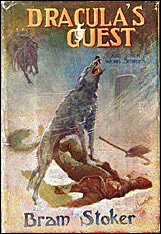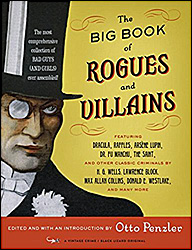Sat 7 Oct 2017
Stories I’m Reading: BRAM STOKER – Dracula’s Guest.
Posted by Steve under Science Fiction & Fantasy , Stories I'm Reading[4] Comments

BRAM STOKER – Dracula’s Guest. Published posthumously in the collection Dracula’s Guest and Other Weird Stories (George Routledge & Sons, UK, hardcover, 1914). Reprinted many times including: Weird Tales, December 1927; The Ghouls, edited by Peter Haining (W. H. Allen, UK, hardcover, 1971; Pocket, US, paperback, April 1971); Dracula’s Guest and Other Stories, edited by Victor Ghidalia (Xerox, US, paperback, 1972); Werewolf!, edited by Bill Pronzini (Arbor House, US, hardcover, 1979); The Vampire Archives: The Most Complete Volume of Vampire Tales Ever Published, edited by Otto Penzler (Vintage Crime/Black Lizard / Vintage Books, softcover, 2009); The Big Book of Rogues and Villains, edited by Otto Penzler (Vintage Crime/Black Lizard, softcover, October 24 2017). Film: Among others “inspired” by the story, Universal’s film Dracula’s Daughter (1936) was supposedly based on the tale, but nothing of the plot was used.
It is generally stated and accepted that this story, somewhat complete in itself, was the the first chapter of the original manuscript of Dracula, but deleted for reasons of length. It is told by an unknown narrator, but presumably it was Jonathan Harker who very foolishly ignores the advice of his innkeeper and the coachman of his carriage to get out to investigate on foot a village said to be unholy and abandoned for some 300 years.
On Walpurgis Night, no less. Needless to say, he soon realizes that he has made a dangerous mistake. Some thoughts. First of all, how modern Stoker’s writing is. This is story that could easily pass as having been written last week, if not yesterday. Secondly, it is wonder how well this story anticipates all those Hammer horror films that came along so many years later.
BONUS:
Here are the stories included in the Rogues and Villains anthology:

THE VICTORIANS
At the Edge of the Crater by L. T. Meade & Robert Eustace
The Episode of the Mexican Seer by Grant Allen
The Body Snatcher by Robert Louis Stevenson
Dracula’s Guest by Bram Stoker
The Narrative of Mr. James Rigby by Arthur Morrison
The Ides of March by E. W. Hornung
19TH CENTURY AMERICANS
The Story of a Young Robber by Washington Irving
Moon-Face by Jack London
The Shadow of Quong Lung by C. W. Doyle
THE EDWARDIANS
The Fire of London by Arnold Bennett
Madame Sara by L. T. Meade & Robert Eustace
The Affair of the Man Who Called Himself Hamilton Cleek by Thomas W. Hanshew
The Mysterious Railway Passenger by Maurice Leblan
An Unposted Letter by Newton MacTavish
The Adventure of “The Brain†by Bertram Atkey
The Kailyard Novel by Clifford Ashdown
The Parole of Gevil-Hay by K. & Hesketh Prichard
The Hammerspond Park Burglary by H. G. Wells
The Zayat Kiss by Sax Rohmer
EARLY 20TH CENTURY AMERICANS
The Infallible Godahl by Frederick Irving Anderson
The Caballero’s Way by O. Henry
Conscience in Art by O. Henry
The Unpublishable Memoirs by A. S. W. Rosenbach
The Universal Covered Carpet Tack Company by George Randolph Chester
Boston Blackie’s Code by Jack Boyle
The Gray Seal by Frank L. Packard
The Dignity of Honest Labor by Percival Pollard
The Eyes of the Countess Gerda by May Edginton
The Willow Walk by Sinclair Lewis
A Retrieved Reformation by O. Henry
BETWEEN THE WORLD WARS
The Burglar by John Russell
Portrait of a Murderer by Q. Patrick
Karmesin and the Big Flea by Gerald Kersh
The Very Raffles-Like Episode of Castor and Pollux, Diamonds De Luxe by Harry Stephen Keeler
The Most Dangerous Game by Richard Connell
Four Square Jane by Edgar Wallace
A Fortune in Tin by Edgar Wallace
The Genuine Old Master by David Durham
The Colonel Gives a Party by Everett Rhodes Castle
Footsteps of Fear by Vincent Starrett
The Signed Masterpieces by Frederick Irving Anderson
The Hands of Mr. Ottermole by Thomas Burke
“His Lady†to the Rescue by Bruce Graeme
On Getting an Introduction by Edgar Wallace
The 15 Murderers by Ben Hecht
The Damsel in Distress by Leslie Charteris
THE PULP ERA
After-Dinner Story by William Irish
The Mystery of the Golden Skull by Donald E. Keyhoe
We Are All Dead by Bruno Fischer
Horror Insured by Paul Ernst
A Shock for the Countess by C. S. Montanye
A Shabby Millionaire by Christopher B. Booth
Crimson Shackles by Frederick C. Davis
The Adventure of the Voodoo Moon by Eugene Thomas
The Copper Bowl by George Fielding Eliot
POST-WORLD WAR 2
The Cat-Woman by Erle Stanley Gardner
The Kid Stacks a Deck by Erle Stanley Gardner
The Theft from the Empty Room by Edward D. Hoch
The Shill by Stephen Marlowe
The Dr. Sherrock Commission by Frank McAuliffe
In Round Figures by Erle Stanley Gardner
The Racket Buster by Erle Stanley Gardner
Sweet Music by Robert L. Fish
THE MODERNS
The Ehrengraf Experience by Lawrence Block
Quarry’s Luck by Max Allan Collins
The Partnership by David Morrell
Blackburn Sins by Bradley Denton
The Black Spot by Loren D. Estleman
Car Trouble by Jas A. Petrin
Keller on the Spot by Lawrence Block
Boudin Noir by R. T. Lawton
Like a Thief in the Night by Lawrence Block
Too Many Crooks by Donald E. Westlake